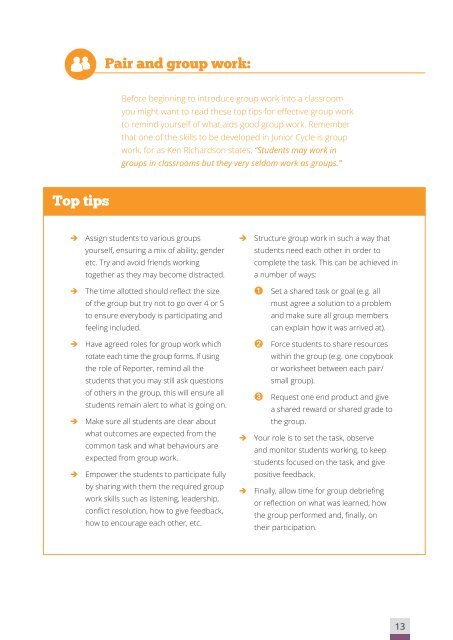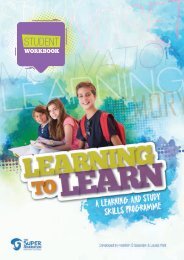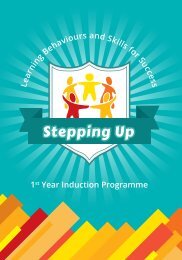Learning to Learn - Teacher Manual Introduction
The Learning to Learn programme is aimed at embedding a culture of learning and study at Junior Cycle. One of the key objectives of the Junior Cycle is to place the student at the centre of the teaching and learning. Students today are facing the challenge of ongoing changes in the nature of knowledge and the need for the requisite skills to process this increasing amount of information. This programme will assist students in knowing themselves better as learners, being more organised and confident along with having a proven study system and learning approach which will reduce their stress levels and add to their sense of well-being.
The Learning to Learn programme is aimed at embedding a culture of
learning and study at Junior Cycle. One of the key objectives of the Junior Cycle is to place the student at the centre of the teaching and learning. Students today are facing the challenge of ongoing changes in the nature of knowledge and the need for the requisite skills to process this increasing amount of information.
This programme will assist students in knowing themselves better as learners,
being more organised and confident along with having a proven study system
and learning approach which will reduce their stress levels and add to their
sense of well-being.
Create successful ePaper yourself
Turn your PDF publications into a flip-book with our unique Google optimized e-Paper software.
Pair and group work:<br />
Before beginning <strong>to</strong> introduce group work in<strong>to</strong> a classroom<br />
you might want <strong>to</strong> read these <strong>to</strong>p tips for effective group work<br />
<strong>to</strong> remind yourself of what aids good group work. Remember<br />
that one of the skills <strong>to</strong> be developed in Junior Cycle is group<br />
work, for as Ken Richardson states, “Students may work in<br />
groups in classrooms but they very seldom work as groups.”<br />
Top tips<br />
Assign students <strong>to</strong> various groups<br />
yourself, ensuring a mix of ability, gender<br />
etc. Try and avoid friends working<br />
<strong>to</strong>gether as they may become distracted.<br />
The time allotted should reflect the size<br />
of the group but try not <strong>to</strong> go over 4 or 5<br />
<strong>to</strong> ensure everybody is participating and<br />
feeling included.<br />
Have agreed roles for group work which<br />
rotate each time the group forms. If using<br />
the role of Reporter, remind all the<br />
students that you may still ask questions<br />
of others in the group, this will ensure all<br />
students remain alert <strong>to</strong> what is going on.<br />
Make sure all students are clear about<br />
what outcomes are expected from the<br />
common task and what behaviours are<br />
expected from group work.<br />
Empower the students <strong>to</strong> participate fully<br />
by sharing with them the required group<br />
work skills such as listening, leadership,<br />
conflict resolution, how <strong>to</strong> give feedback,<br />
how <strong>to</strong> encourage each other, etc.<br />
Structure group work in such a way that<br />
students need each other in order <strong>to</strong><br />
complete the task. This can be achieved in<br />
a number of ways:<br />
➊<br />
➋<br />
➌<br />
Set a shared task or goal (e.g. all<br />
must agree a solution <strong>to</strong> a problem<br />
and make sure all group members<br />
can explain how it was arrived at).<br />
Force students <strong>to</strong> share resources<br />
within the group (e.g. one copybook<br />
or worksheet between each pair/<br />
small group).<br />
Request one end product and give<br />
a shared reward or shared grade <strong>to</strong><br />
the group.<br />
Your role is <strong>to</strong> set the task, observe<br />
and moni<strong>to</strong>r students working, <strong>to</strong> keep<br />
students focused on the task, and give<br />
positive feedback.<br />
Finally, allow time for group debriefing<br />
or reflection on what was learned, how<br />
the group performed and, finally, on<br />
their participation.<br />
13






